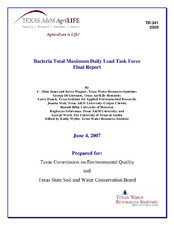| dc.description.abstract | In September 2006, the Texas Commission on Environmental Quality (TCEQ) and Texas State Soil and Water Conservation Board (TSSWCB) charged a seven-person Bacteria Total Maximum Daily Load (TMDL) Task Force with:
* examining approaches that other states use to develop and implement bacteria TMDLs,
* recommending cost-effective and time-efficient methods for developing TMDLs,
* recommending effective approaches for developing TMDL Implementation Plans (I-Plans),
* evaluating a variety of models and bacteria source tracking (BST) methods available for developing TMDLs and I-Plans, and recommending under what conditions certain methods are more appropriate, and
* developing a roadmap for further scientific research needed to reduce uncertainty about how bacteria behave under different water conditions in Texas.
The Task Force, assisted by an Expert Advisory Group of approximately 50 stakeholders and agency staff, held two two-hour meetings/teleconferences and developed two drafts of the report. These drafts were shared by e-mail and on a Web site and feedback received from the Expert Advisory Group was also made available on the Web site.
The Task Force report describes the characteristics, as well as some of the strengths and weaknesses of several models that have been used and/or are under development to assist bacteria TMDL and I-Plan analysis. These include:
* load duration curves (LDC),
* spatially explicit statistical models, including Arc Hydro, SPARROW and SELECT,
* the mass balance models BLEST and BIT, and
* the mechanistic hydrologic/water quality models HSPF, SWAT, SWMM and WASP.
The Task Force report also describes and makes recommendations for effective use of BST methods that have been used in Texas and elsewhere for TMDL development. These include ERIC-PCR, Ribotyping, PFGE, KB-ARA, CSU and Bacteroidales PCR. Based on recent experience in Texas and elsewhere, the Task Force recommends using library-independent methods like Bacteriodales PCR for preliminary qualitative analyses and more expensive and time-consuming library-dependent methods if more quantitative data are required for TMDL or I-Plan development.
Based on the discussions of bacteria models and source tracking, as well as extensive input from the Expert Advisory Group, the Task Force recommends a three-tier approach to implementing bacteria TMDLs and I-Plans.
Tier 1 is a one-year process that includes the formation of a representative stakeholder group, development of a comprehensive geographic information system (GIS) of the watershed, a survey of potential bacterial sources, calculation of load duration curves from existing monitoring data and analysis by agency personnel and stakeholders of data collected for Tier 1. After reviewing information from Tier 1, the group may choose to complete and submit a draft TMDL for agency approval, request an evaluation of the designated use of the water body (an use attainability analysis) or proceed to Tier 2.
Tier 2 is a one-to-two-year effort designed to collect targeted monitoring data to fill gaps in previously collected data, conduct qualitative library-independent BST data to determine whether humans and/or a few major classes of animals are sources and develop simple spatially explicit or mass balance models of bacteria in the watershed. After analysis of Tier 1 and Tier 2 data, the group may chose to complete and submit the draft TMDL (or I-Plan if a TMDL was developed after Tier 1), request an evaluation of the designated use (an use attainability analysis), or initiate a “phased TMDL” and proceed with Tier 3 analysis.
Tier 3 is a two-to-three-year process designed to continue strong stakeholder involvement, implement more extensive targeted monitoring, conduct quantitative library-dependent BST analysis and develop a detailed hydrologic/water quality model for the watershed. Tier 3 should be implemented only when this level of detailed analysis is needed for I-Plan development or for TMDL development for particularly complex watersheds for which consensus cannot be reached after Tier 2.
The Task Force emphasizes that the agencies and stakeholders may choose to deviate from these recommendations if they reach consensus that a more time- and cost-effective approach is feasible.
The Task Force concludes its report by summarizing a number of research activities needed to strengthen the scientific tools available for TMDL and I-Plan development. The needed research falls into the following categories: characterization of sources, characterization of kinetic rates and transport mechanisms, enhancements to bacteria fate and transport models and bacteria source tracking, determination of effectiveness of control mechanisms and quantification of uncertainty and risk. | en |


